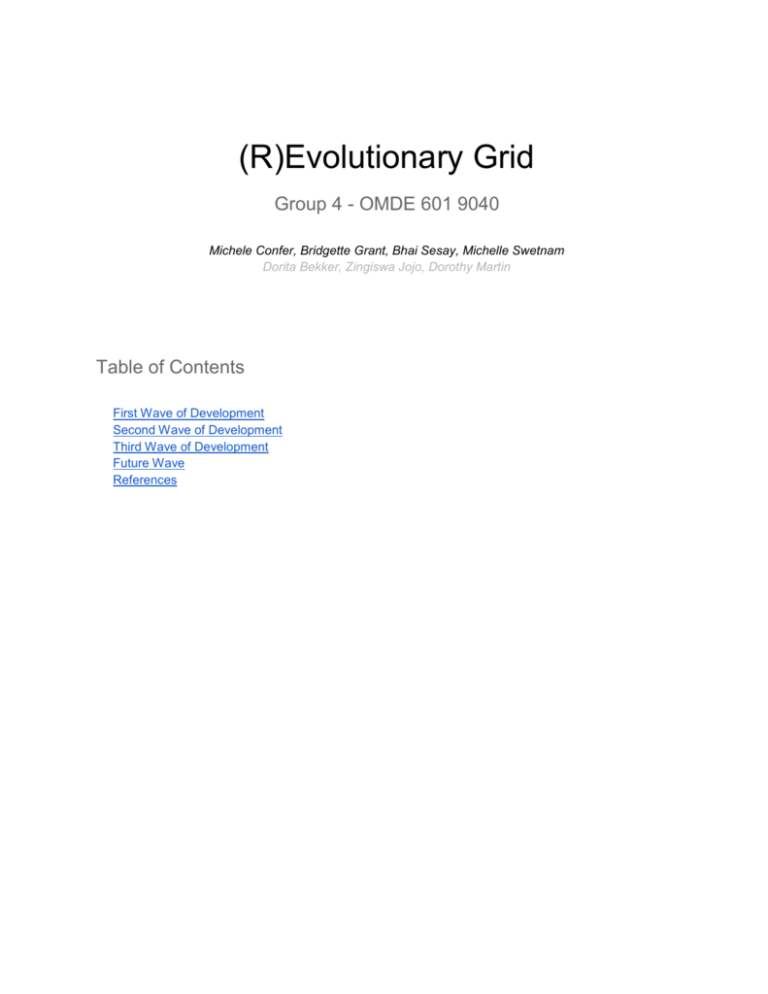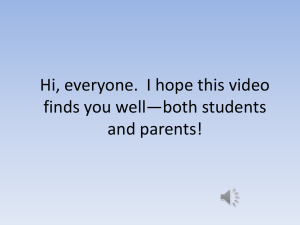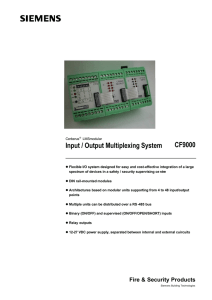Skill Builder 6 – Waves 1 and 2 – Group Grid
advertisement

(R)Evolutionary Grid Group 4 - OMDE 601 9040 Michele Confer, Bridgette Grant, Bhai Sesay, Michelle Swetnam Dorita Bekker, Zingiswa Jojo, Dorothy Martin Table of Contents First Wave of Development Second Wave of Development Third Wave of Development Future Wave References (R)EVOLUTIONARY GRID (GROUP 4) - OMDE 601 9040 1 First Wave of Development Correspondence / Independent Study (1840’s …) 1 Larger Context economics, politics, societal values and pressures, government policies, technological advances ➔ Industrialization grew need for workers to receive education due to changes in technological, vocational, and social conditions (Peters, 2004) ➔ Postal service and radio broadcasting ➔ Training employee and armed forces ➔ Women education advancement ➔ Need to educate learners in remote places ➔ First used to offer higher education courses by Chautauqua Correspondence College (Moore & Kearsley, 2011) ➔ Affordable and economical for employees to obtain education by using payroll deductions (Moore & Kearsley, 2011) ➔ Mass education - closing the educational gap between the elite and white-collar workers 2 Theories/Ways of Understanding ➔ Empathy and guided didactic conversation (Holmberg, 1983) ➔ Tony Bates-1960s Open Universities/UK ➔ Malcolm Shepherd Knowles (1913 – 1997) use of Andragogy for adult education ➔ There is Learner autonomy and independence ➔ Self-paced learning vs.prescribed pacing 3 Institutional and Organizational Developments/Systems ➔ Correspondence education developed by entrepreneurs who saw how they could profit from the need for education at a distance, profit gained by mass distribution was higher because more students could enroll (Peters, 2004) ➔ International Correspondence Schools ➔ Sir Isaac Pittman (Correspondence College,1840) ➔ Home Correspondence Schools ➔ American Farmers’ School ➔ Land grant universities ➔ United States Armed Forces Institute ➔ Single Mode Open Universities ➔ Consortia & inter-institutional collaboration (Miller, 2010) 4 Teaching/Learning Methodologies ➔ Planned instructional materials created by instructors and delivered to students, usually one-way communication from instructor to learner; ➔ Students expected to study independently (Garrison & role of teacher, role of learner (R)EVOLUTIONARY GRID (GROUP 4) - OMDE 601 9040 2 ➔ ➔ ➔ ➔ ➔ ➔ ➔ ➔ Cleveland-Innes, 2010) Real and written conservation between learner and teacher or institution of learning Shorthand writing Asynchronous learning There is a tendency for teacher sympathy Empathy approach Less formal interactions with teacher and student which could lead to not feeling isolated Quick turnaround with interactions Individual studies 5 Predominant Technologies ➔ Printed material delivered by railroads and postal system (Peters, 2004) ➔ Courses were also offered via radio broadcast ➔ Self-instructional materials ➔ Radio/phonography (Peters, 2004) ➔ Television/telecourses ➔ Private companies & public (CPB) (Moore & Kearsley, 2011) ➔ A blend of televised programs with textbooks for both learners and instructors 6 Key Authors ➔ ➔ ➔ ➔ ➔ ➔ ➔ ➔ ➔ ➔ ➔ References Thomas Jefferson Forster (home study courses) Otto Peters (sui generis) Borje Holmberg (utility of Bloom’s taxonomy) Desmond Keegan (foundations of DE; different from traditional education) Anna Eliot Ticknor (First Correspondence School in USA) Wedemeyer (pioneer in theoretical development of DE. He focused on the characteristic of independent study that provided access to socially disadvantaged individuals (Cleveland-Innes & Garrison, 2010).) Lev Vygotsky (sociocultural theory) William Harper (structured correspondence courses) Isaac Pitman (shorthand by mail) Caleb Phillips (teacher of new method of shorthand) George Buck (technology for instruction. Ideas, practices and theory in education) (R)EVOLUTIONARY GRID (GROUP 4) - OMDE 601 9040 3 Second Wave of Development Systems Approach to Education (1960’s …) 1 Larger Context economics, politics, societal values and pressures, government policies, technological advances ➔ Move toward learner-centered education, lifelong and autonomous ➔ Demographic changes and the demand ➔ More learners after World War II ➔ Rise of white-collar work, need for education ➔ Demand for economies of scale ➔ 2 Theories/Ways of Understanding ➔ Constructivism Theory - “all learning occurs in our minds as we create and adjust internal mental structures to accommodate our ever-growing and ever-changing stories of knowledge” (Piaget, 1957, as cited in Swan, 2010, p. 113) ➔ Andragogy Theory - self-directed, task-oriented, motivated, relies on life experience (Bullen, 1995) ➔ Theory of the Most Industrialized Education ➔ Dialogue, Structure, and Learner Autonomy; Transactional Distance ➔ Systems approach way of teaching ➔ Self directed learners, who are actively involved in learning ➔ Egalitarianism ➔ Equality of educational opportunity ➔ Lifelong and ubiquitous learning ➔ There are new functions of higher education ➔ Flexible curricula and new types of students ➔ 3 Institutional and Organizational Developments/Systems ➔ Open University ➔ Single- and dual-mode universities ➔ Teams are responsible for content creation, rather than individual teachers ➔ Administration, staff, faculty the organization is restructured ➔ Commercial distance teaching institutions ➔ Purposive rationality, goal-oriented systematic action, modern bureaucracy, advanced technology and systems approach (Peters, 2010) 4 Teaching/Learning Methodologies ➔ ➔ ➔ ➔ role of teacher, role of learner Self directed learning for students Teachers are more like facilitators Instructional Design and Educational Technology Cognitive-behaviorist (R)EVOLUTIONARY GRID (GROUP 4) - OMDE 601 9040 4 ➔ Social constructivist ➔ Connectivist pedagogy ➔ Students organized local study groups, institutions must provide resources such as counseling and tutoring (Moore, 2012) ➔ Learning by doing, collaboration, active learning, creating meaning (constructivism) 5 Predominant Technologies ➔ ➔ ➔ ➔ ➔ ➔ ➔ Broadcasting (television and radio) Satellite transmission Printed material Audiovisual materials Audio and video cassettes Fax Teleconferencing 6 Key Authors ➔ ➔ ➔ ➔ ➔ ➔ ➔ Peters (open university as industrialized education) Bates (Open University United Kingdom) Wedemeyer (University of Wisconsin correspondence study) Holmberg Knowles (andragogy) Moore (transactional distance) Piaget (constructivism) References (R)EVOLUTIONARY GRID (GROUP 4) - OMDE 601 9040 5 Third Wave of Development Internet/Web-Based Communication (1995 …) 1 Larger Context economics, politics, societal values and pressures, government policies, technological advances 2 Theories/Ways of Understanding 3 Institutional and Organizational Developments/Systems 4 Teaching/Learning Methodologies role of teacher, role of learner 5 Predominant Technologies 6 Key Authors References (R)EVOLUTIONARY GRID (GROUP 4) - OMDE 601 9040 6 Future Wave Exploring New Possibilities (2000’s …) 1 Larger Context ➔ economics, politics, societal values and pressures, government policies, technological advances 2 Theories/Ways of Understanding ➔ 3 Institutional and Organizational Developments/Systems ➔ 4 Teaching/Learning Methodologies ➔ role of teacher, role of learner 5 Predominant Technologies ➔ 6 Key Authors ➔ (R)EVOLUTIONARY GRID (GROUP 4) - OMDE 601 9040 7 References Bates, A. W. (2011, November). The second wave of distance education and history of the Open University United Kingdom [Online video]. Available from http://vimeo.com/32292234 (Transcript: http://www.box.com/s/cvygk4334sub0i6atrn8) Bullen, M. (1995, June). Andragogy and university distance education. Paper presented to the 17th conference on the International Council for Open and Distance Education, Birmingham, UK. Available from http://www.box.com/s/ap4nq2zf1jujkyo65pz0 Garrison, D. R. & Cleveland-Innes, M. F. (2010). Foundations of distance education. In M. F. Cleveland-Innes and D. R. Garrison, An introduction to distance education: Understanding teaching and learning in a new era. New York and London: Routledge. Holmberg, B. (1983). Guided didactic conversation in distance education. In D. Sewart, D. Keegan, and B. Holmberg (Eds.), Distance education: International perspectives. London: Croom Helm. Retrieved from http://www.c3l.uni-oldenburg.de/cde/support/readings/holm83.pdf Moore, M. G. & Kearsely, G. (2012). Distance education: A systems view (3rd edition). California: Cengage Learning. Peters, O. (2004). Distance education in transition: New trends and challenges (4th edition). Oldenburg, Germany: BIS-Verlag der Carl von Ossietzky Universität Oldenburg. Retrieved from http://www.box.com/shared/5x3tpynqqf Swan, K. (2010). Teaching and learning in post-industrial distance education. In M. F. Cleveland-Innes & D. R. Garrison (Eds.), An introduction to distance education: Understanding teaching and learning in a new era. New York & London: Routledge.










